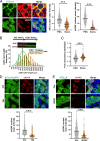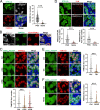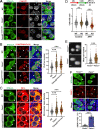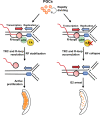Transcription-replication conflicts in primordial germ cells necessitate the Fanconi anemia pathway to safeguard genome stability
- PMID: 35969748
- PMCID: PMC9407672
- DOI: 10.1073/pnas.2203208119
Transcription-replication conflicts in primordial germ cells necessitate the Fanconi anemia pathway to safeguard genome stability
Abstract
Preserving a high degree of genome integrity and stability in germ cells is of utmost importance for reproduction and species propagation. However, the regulatory mechanisms of maintaining genome stability in the developing primordial germ cells (PGCs), in which rapid proliferation is coupled with global hypertranscription, remain largely unknown. Here, we find that mouse PGCs encounter a constitutively high frequency of transcription-replication conflicts (TRCs), which lead to R-loop accumulation and impose endogenous replication stress on PGCs. We further demonstrate that the Fanconi anemia (FA) pathway is activated by TRCs and has a central role in the coordination between replication and transcription in the rapidly proliferating PGCs, as disabling the FA pathway leads to TRC and R-loop accumulation, replication fork destabilization, increased DNA damage, dramatic loss of mitotically dividing mouse PGCs, and consequent sterility of both sexes. Overall, our findings uncover the unique source and resolving mechanism of endogenous replication stress during PGC proliferation, provide a biological explanation for reproductive defects in individuals with FA, and improve our understanding of the monitoring strategies for genome stability during germ cell development.
Keywords: Fanconi anemia pathway; genome stability; primordial germ cells; replication stress; transcription–replication conflicts.
Conflict of interest statement
The authors declare no competing interest.
Figures






Similar articles
-
FAAP100 is required for the resolution of transcription-replication conflicts in primordial germ cells.BMC Biol. 2023 Aug 15;21(1):174. doi: 10.1186/s12915-023-01676-1. BMC Biol. 2023. PMID: 37580696 Free PMC article.
-
Fance deficiency inhibits primordial germ cell proliferation associated with transcription-replication conflicts accumulate and DNA repair defects.J Ovarian Res. 2023 Aug 10;16(1):160. doi: 10.1186/s13048-023-01252-9. J Ovarian Res. 2023. PMID: 37563658 Free PMC article.
-
UBE2T resolves transcription-replication conflicts and protects common fragile sites in primordial germ cells.Cell Mol Life Sci. 2023 Mar 16;80(4):92. doi: 10.1007/s00018-023-04733-8. Cell Mol Life Sci. 2023. PMID: 36928776 Free PMC article.
-
[Functions of FANCL in primordial germ cell formation and Fanconi anemia].Yi Chuan Xue Bao. 2005 Sep;32(9):993-1000. Yi Chuan Xue Bao. 2005. PMID: 16201245 Review. Chinese.
-
Regulation of R-loops and genome instability in Fanconi anemia.J Biochem. 2019 Jun 1;165(6):465-470. doi: 10.1093/jb/mvz019. J Biochem. 2019. PMID: 30821334 Review.
Cited by
-
Fancm has dual roles in the limiting of meiotic crossovers and germ cell maintenance in mammals.Cell Genom. 2023 Jun 29;3(8):100349. doi: 10.1016/j.xgen.2023.100349. eCollection 2023 Aug 9. Cell Genom. 2023. PMID: 37601968 Free PMC article.
-
Genome-wide landscape of miRNA-mRNA-lncRNA-circRNA ceRNA network in Nanos2 deficient mice.PLoS One. 2025 Jun 27;20(6):e0325260. doi: 10.1371/journal.pone.0325260. eCollection 2025. PLoS One. 2025. PMID: 40577378 Free PMC article.
-
Biallelic BRCA2 variants induce premature ovarian insufficiency by impaired meiotic homologous recombination.Commun Biol. 2025 Jul 25;8(1):1104. doi: 10.1038/s42003-025-08426-9. Commun Biol. 2025. PMID: 40715368 Free PMC article.
-
Participants in Transcription-Replication Conflict and Their Role in Formation and Resolution of R-Loops.Int J Mol Sci. 2025 Jul 19;26(14):6951. doi: 10.3390/ijms26146951. Int J Mol Sci. 2025. PMID: 40725198 Free PMC article. Review.
-
RNase H1 facilitates recombinase recruitment by degrading DNA-RNA hybrids during meiosis.Nucleic Acids Res. 2023 Aug 11;51(14):7357-7375. doi: 10.1093/nar/gkad524. Nucleic Acids Res. 2023. PMID: 37378420 Free PMC article.
References
-
- Suh E. K., et al. , p63 protects the female germ line during meiotic arrest. Nature 444, 624–628 (2006). - PubMed
Publication types
MeSH terms
LinkOut - more resources
Full Text Sources
Molecular Biology Databases

